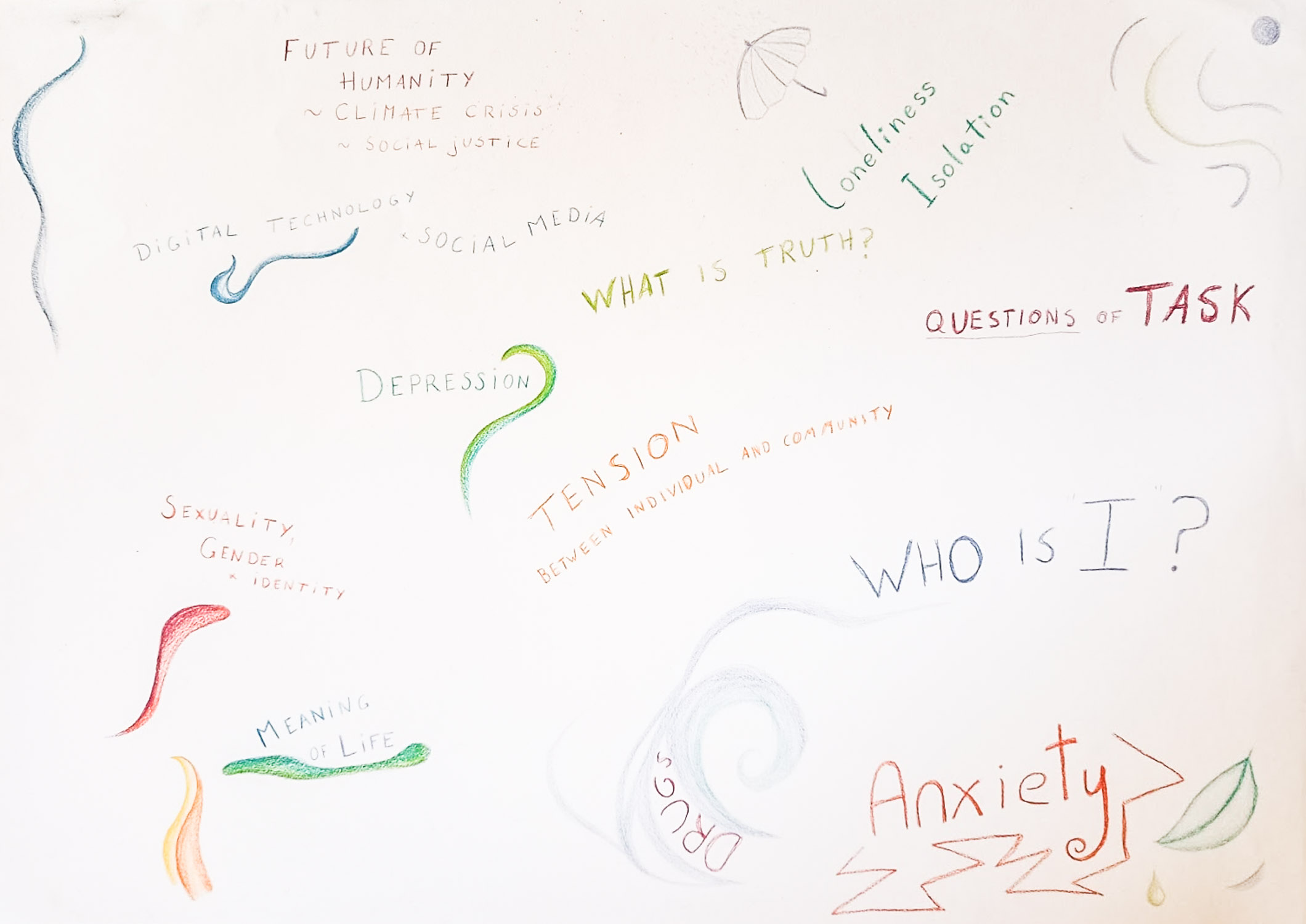For her final presentation during the Anthroposophical Studies program at the Goetheanum, Rosemary Channin explored the question, “Are Rudolf Steiner’s indications for young people still relevant in 2023?” by researching Steiner’s addresses to young people, polling students at the Goetheanum on their major challenges, and looking at how Steiner’s tasks relate to the experiences of young folk today.
The Impulse Behind the Project
Today’s young people face the rapid advancement of technology and AI, serious political unrest in many parts of the world, the impact of the Russia-Ukraine war, and an ever-increasing cost of living. Life is accelerating, and young people are struggling to find their place and way in the world without losing their youthfulness. Our (often unconscious) search and longing for the spirit is perhaps more significant and more urgent than ever.
Around 100 years ago, when the world was beginning to find itself again after World War I, Steiner gave a course of lectures to young people who were seeking answers to questions similar to our own (The Younger Generation, GA 217). The old, pre-war ways of life no longer felt right, and they were seeking to move forward and create new ways of living and relating.
According to Steiner, souls born at that time were coming with something new: before incarnation, they had experienced the dawning of the Michael Age in the spiritual world and knew themselves to be a part of it. They brought this feeling with them into their new lives on Earth. However, the old ways and traditions were still strong among the older generations, and the young people felt this dissonance deeply. Steiner warned these young people that, without the necessary courage, the world would descend even further into materialism and intellectualism. These are two of the primary forces that form the “dragon” which we must overcome. Michael can help humankind overcome this dragon, but he doesn’t force himself upon us. We must choose to strengthen ourselves and to permeate ourselves with living spirit.

Steiner’s Tasks for Youth
Steiner’s tasks for the youth were given in light of the consciousness soul epoch and the beginning of the Michael Age to which we belong. These tasks, which can be found in his addresses to young people and other relevant reading, including GA 217, 217a, and 266 vol. 3, can be summarised as follows:
- To meet and conquer the “dragon”—we cannot run or hide from it.
- To work out of spiritual activity with the childlike qualities of always seeking, questioning, and being open-minded—in short, to nurture one’s inner activity and growth forces.
- To become companions of Michael.
- To build a chariot for Michael so that he can come to Earth and truly work with us. We can build this through nurturing “a living humanity such as flows out of super-sensible worlds into the earthly life and manifests there, precisely in the early periods of human life.” In other words, we must cultivate a living humanity in children through art- and heart-centred education.
When he spoke to young people 100 years ago, in the aftermath of the First World War, Steiner gave three primary indications for beginning to undertake these enormous tasks:
- We must undertake individual inner work to find our own relationship to the spiritual world and be able to do so in full consciousness.
- We must form spiritual-scientific research groups based on meditating and studying together. This suggestion became the beginning of a young people’s esoteric meditation group and what soon became the Youth Circle mantras.1
- We must educate children through art and imagination so that beauty becomes a way of understanding truth.
The Challenges of Youth in 2023: A Workshop
To look at the relevance of these tasks and indications today, I created and ran a workshop in the Youth Section House at the Goetheanum with two groups of young people to discover the main challenges they are facing in today’s society. Keeping in mind Steiner’s conversations with the young people 100 years ago, I asked my group participants to think about their longings and needs. I invited them to consider both inner and outer aspects of their experiences. Each group created a poster to summarise their thoughts, and these formed part of the display for my final presentation.
I hoped to formulate some core patterns and themes from their answers. However, while some were clear to me, others overlapped so much that it was difficult to categorise them with any precision. This is interesting in itself, since it seems to imply that what they are experiencing is not a set of symptoms that can be put into neat boxes, but rather that everything is intertwined and interconnected in our unique physical-soul-spiritual-I experiences. Nevertheless, I have tried to loosely group their answers into four categories:

The young people participating in the workshop came from several continents, and many had lived or travelled extensively in different countries. Some of those who had lived in two or more countries described feeling “uprooted.” On the one hand, their feeling was one of freedom and that the world is waiting to be explored, and on the other hand, there was a deep soul experience of the loss of roots and one’s given identity (“Where do I belong?”; “More than one place (or no place) feels like home.”) To me, this experience of uprootedness belongs in part to all four categories, not just one. It is also a “modern” experience—the young people in Steiner’s time would most likely not have experienced it to the same extent, since it was more difficult to travel internationally back then.
I devised some “tasks of youth” for young people in 2023 based on the central themes that emerged from the workshop. Three main tasks arose out of the answers from the “Challenges of being young today” workshop:
- Know yourself. Observe and discover, with deep honesty, your strengths, weaknesses, soul life, and moral ideals. Through knowing yourself, you can learn to meet the world, and through understanding the world, you can find your place in it, that is, your purpose and sense of belonging.2
- Inner work. School the inner soul life (thinking, willing, feeling, positivity, open-mindedness) through, for example, meditation and Steiner’s six basic exercises in preparation for meeting the challenges of the outer world coming towards us with increasing speed and severity.
- Relationships with others. Realise that every encounter is spiritual, no matter how different someone is compared to you. Learn to work together despite differences. See the human being in each other.
Are Steiner’s Tasks of Youth Still Relevant in 2023?
Based on the perspectives of the challenges faced by young people today, as described by those taking part in the workshop and my own experiences and observations, it is clear that Steiner’s tasks are not only still relevant but have become even more urgent than they were 100 years ago. We are now further into the consciousness soul epoch and the Age of Michael, and the dragon has become exponentially stronger since Steiner’s time, particularly with the advancement of the digital life-world of the internet.3 The dragon acts as a doorway for the harmful spiritual forces (Luciferic, Ahrimanic, Asuric, Zoratic, etc.) seeking to influence humankind. Young people are especially at risk since they have never known a life without the internet, mobile phones, and similarly advanced technology, and their elders have not modeled ways to protect themselves. Inner work is therefore very much needed to build inner strength and stability, and to develop clear, living thinking and strong will forces.
Young people need opportunities to develop away from the pressures of life and society; they need chances to be truly youthful. One suggestion for education is to use activities that have a feeling of breathing in and breathing out (something already used in Waldorf schools) and to apply this to the use of technology. This could be combined with teaching children to use technology with intention and consciousness and educating them on the dangers so that they are aware that it’s a tool that must be used carefully. Additionally, in a “post-truth world,” where you can google the answer to just about anything, where opinions on the internet can look like facts, and photos can be filtered or altered, an education that teaches children how to distinguish what’s true or not is desperately needed.
Many of the challenges described by young people both in Steiner’s time and today are symptoms of a cry for the spirit. Young people feel this deeply in their souls to the point that it is existential. Steiner’s tasks relating to the Age of Michael and the consciousness soul epoch are particularly relevant here since they will bring young people into an encounter with that which they are seeking—they will find the spirit in others, in the world, and in themselves. Today, even more so than 100 years ago, people are (often) unable to find the spirit in each other, noticing only the separateness of themselves and the other, and this is often encouraged in the online world, where groups of people form against each other due to differences of opinion or beliefs. Regarding relationships between young people specifically, Steiner was very explicit in his “Youth in an Age of Light” lecture that young people must “hold together with an iron will” and find each other “even in the greatest differences of feeling.”4

Stepping Stones for the Future
This research can be taken further in the future. I could repeat the workshop with a larger number of participants, including those who do not have an anthroposophical background. I could also compare findings with similar anthroposophical research focused on the experiences of young people today, for example the (Re)Search project by Andrea de la Cruz, Ioana Viscrianu and Constanza Kaliks at the Goetheanum Youth Section, which was undertaken between 2017 and 2021.5
As is typical of Anthroposophical research, my findings led me to further questions. What can we do to help young people navigate the challenges of our time when we haven’t experienced some of these things ourselves, particularly the rapid advancement of technology and AI? How can we help young people to cultivate greater inner resilience?
When I began to think about how to answer these questions, I remembered Steiner’s Awakening to Community lectures (GA 257), and it came to me that one of the most important things that young people can do today is spend time with each other, forming and nurturing friendships, and sharing their searching and striving. One place where this is already happening across the world is in the Youth Section. There, young people have a safe space to ask their questions and to come together to face life’s challenges. My experience of being part of the Youth Section, both as a member and a coordinator in the UK, is that there is a feeling of coming home, of finding somewhere that the part of you that longs to be nurtured spiritually can be held and can find a space to explore in the company of kindred spirits. The Youth Section is needed more than ever, given the challenges that today’s young people face, and so it was wonderful to have been part of the Worldwide Youth Coworkers’ Gathering at the Goetheanum in July 2023. Together, we are stronger and stand united in courage and the hope that we can continue to build a worldwide support network for young people who are seeking answers that cannot be found in the materialism of outer life.
More For the full project report, email rosemarychannin@gmail.com
Footnotes
- Steiner, R., Esoteric Lessons, GA 266.
- This topic was spoken about in detail by Joan Melé in a Goetheanum TV broadcast about Social Threefolding and the Task of Youth today.
- Schmidt, Robin. “Shaping Digital Transformation: Perspectives for society and education in a digital world.” Perspectives, 1-2021.
- Steiner, R., Youth in an Age of Light, GA 217a.
- (Re)Search 2017-2021.









